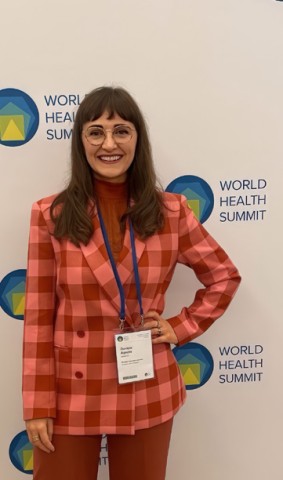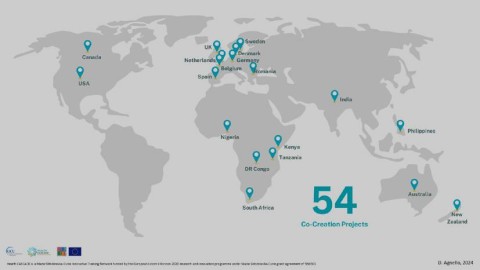Special Issue: Open Science in its many forms - How Open Science transformed my PhD into a global collaboration platform
Newsletter
What if your Open Access requirement turned into something unexpected? Mine started as just another box to tick for my PhD, but it grew into a global collaboration platform that now helps researchers and practitioners in 19 countries design evidence-based co- creation. This collaborative process was mutually beneficial, expanding my network and opening my eyes to the broader impact of my work.
Bionote
Danielle Marie Agnello is dedicated to building healthier, more inclusive communities. As Health CASCADE’s methods expert, she specializes in co-creation, participatory research, and workshop facilitation, focusing on sustainable impact. A global health expert with five years at the World Health Organization, she brings expertise in mixed- methods research and international project management to advance health initiatives globally. During her PhD at Glasgow Caledonian University, Danielle systematically sourced and evaluated co-creation methods and developed widely accessed open-source guidance documents and datasets, aiming to address barriers researchers face in implementing evidence-based co-creation.

When I started my Marie Curie PhD fellowship, I knew I would need to make my research Open Access. It seemed straightforward: publish, share, and move on. But would Open Access actually make a difference, or was it just another box to tick?
During my PhD, I studied co-creation methods—in simple terms, structured ways to engage communities and stakeholders in developing solutions to complex issues. I reviewed, categorized, and analyzed hundreds of methods from both academic and grey literature. As I began sharing some findings, something unexpected happened. People started reaching out. Researchers, practitioners, and students were eager for more. They wanted quick access to this data so they could apply it directly to their projects.
Making a Methods Selector tool
What began as an Open-Access requirement quickly became an opportunity to create something valuable—a tool to help users navigate the often overwhelming world of co-creation. So, what is this tool, and why am I building it?
I would like to say I was immediately excited to put all this data into a tool, but honestly, it was overwhelming. The data was scattered across articles and reports, each offering a different take on what works best in co- creation and formatted in various ways. The deeper I went, the more I realized that other researchers likely faced the same frustration. How do you find the right co-creation method, especially with hundreds of options and limited guidance?
Then the idea hit. Instead of letting these findings sit in a paper or dataset, why not make them available in a user-friendly, searchable format? That’s how the Co-Creation Methods Selector tool came to life. It now allows users to:
• Browse through almost 700 methods with detailed descriptions
• Filter and search for methods suited to their project needs
• Access insights from both academic and non-academic sources
• Add comments, communicate with others, and contribute new methods
Global reach, real-world feedback
By the time I launched the tool’s first prototype in November 2023, recruitment, which could have been challenging, became almost effortless. People were excited to join, and within weeks, I had 54 users from 19 countries—people from diverse backgrounds who wanted to use the tool to design their co- creation projects.
The tool’s live feedback feature allowed users to suggest improvements, from adding intuitive filters to adjusting the interface. Their input has been invaluable, pushing me to think beyond my initial vision. With an enthusiastic user base, the tool’s next phase is all about co-design to refine it based on real-world needs. This experience showed me that Open Science isn’t just about making data available; it is about making it accessible and useful.
Overcoming challenges in Open Science
Building an Open Access tool for a global audience has been eye-opening and, honestly, challenging. Balancing the need for transparency with my academic goals was not easy, and sharing raw data before publication felt risky. Balancing detail and usability was another challenge; too much information could overwhelm users, so feedback and adjustments were essential.
Launching a rough prototype allowed for real- world testing, though it required flexibility to adapt to changing needs. Aggregating and standardizing data from hundreds of sources was a huge, time-intensive effort, and juggling this alongside my PhD timeline was challenging. These hurdles reminded me that Open Science involves extra work and occasional uncertainty, but the impact makes it worthwhile.
A transformative journey
Becoming a Marie Curie Fellow did not just give me an exciting research project; it changed how I think about research itself. Open Science has shown me the power of creating resources that are accessible, actionable, usable, and shared globally. What started as a requirement became a global collaboration platform that enables people to design evidence-based co-creation.
This journey has been a humbling reminder that when research fills a real need, people will come. Open Science did not just make my research accessible; it helped me build a platform that now connects researchers, practitioners, and students across 19 countries (and counting). This experience has shown me that Open Science is more than a checkbox; it’s about connecting, empowering, and transforming how we work together across borders and disciplines.
Join Us
If you would like to join this journey as a co-designer and user of the tool, please reach out to me at danielle.agnello@gcu.ac.uk.
Danielle Marie Agnello
Marie Curie PhD Fellow, Health CASCADE, Glasgow Caledonian University
Advisory Board Member, Global Health Mentorships
danielle.agnello@gcu.ac.uk
@DannyAgnello_GH
